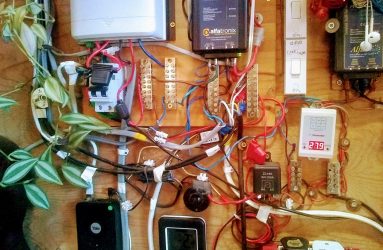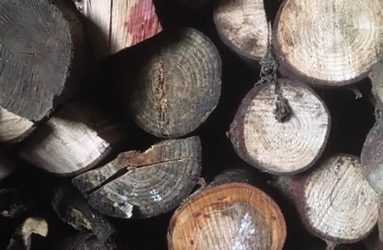
Off-grid living
Elevate artist Hannah Lefeuvre lives off-grid in a small holding in Somerset. This month she reflects on how science supports her off-grid living.
February is a lovely time of year to enjoy a cut-back garden, as bulbs raise their heads and winter sunshine streams through the bare trees and hedgerows, to lift the spirits. At this point in the year, with the palpable increases in daylight and moderately improved temperatures, we breathe a sigh of relief that the worst of the winter is over.
Solar electric
Five solar panels on the east wall of the home and twelve smaller garden panels provide enough electric for most months of the year. Positioned in a sheltered valley, we enjoy protection from storms and heavy winds, but reduced solar in the winter. In the three weeks either side of winter solstice, we depend on the east wall panels, allowing just a few solar hours each morning. As the sun emerges over the southern hill in mid January, we enjoy increased light and from thereon, generally have sufficient supplies. We happily forego many domestic plug-in items throughout the year, while the priority fridge and freezer are kept in cold store, on timers, to maximise solar hours. Our back-up electric comes in the form of lithium batteries and an emergency petrol generator, which sounds a few times each winter.
Water
Outdoor water is harvested into multiple containers throughout the site and regular watering of the polytunnel is a priority. Meanwhile, the outdoor home produce receives water at its seedling stage and thereafter we trust that the mulch, soil moisture and rain will suffice. For domestic use, water is stored in black barrels, and when solar allows, it is electrically pumped and stored in two small barrels in the roof arc of the mezzanine bedroom, to feed the kitchen sink, bath and outdoor shower.
Heating
Our home and water are heated via a solid fuel Rayburn, which we tend to use from October to February. The wood mostly comes from our winter cut backs on site, and is cut and stored a year in advance. Excess Rayburn heat runs into a radiator stationed above it and the back boiler feeds the bath, shower and kitchen sink. If a frost is due, the outdoor shower is turned onto a gentle drip, to avoid pipes bursting.
The image below shows the electronic epicentre of our off-grid system, complete with indoor and outdoor temperature gauges, solar monitors, lithium and lead switches, USB ports, 12 volt sockets and an inverter for higher voltage plug-in chargers. The low voltage makes the wiring safe for the amateur. We keep a close and frequent eye on all of these aspects. It’s a mindful existence, but requires constant attention to keep our life comfortable.
More from Hannah and the Elevate artists
During the spring and summer 2020 Hannah Lefeuvre recorded 13 audio Garden Musings about the nature surrounding her and living off-grid. You can listen to all episodes of Hannah’s Garden Musings here
Download ‘Take the Time’ Issue 6 (pdf)
Send us your contribution
We love to include some of your own reflections in future posts and in our monthly print edition ‘Elevate your mood’ or quarterly printed tabloid ‘Take the time’. Why not write a few lines, try a poem or send us picture on the general theme of spring? Email to ArtCare or send to ArtCare, Block 29, Salisbury District Hospital, Salisbury SP2 8BJ.




